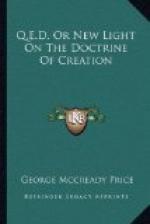[Footnote 16: “Mammals Living and Extinct,” pp. 284-285.]
It would, however, be a very hasty conclusion to say on the basis of these facts that there are no natural limitations to groups of animals and plants. But we are entirely warranted in concluding from these facts that in very many cases, perhaps in most, our system of taxonomic classification of animals and plants has gone altogether too far, and that scientists have erected specific distinctions which are wholly uncalled for and which confuse and obscure the main issues of the species problem. Among the workers in botany and in every department of zooelogy there have always been the “splitters” and the “lumpers,” as they are familiarly called; the former insisting on the most minute distinctions between their “species,” thus multiplying them; the latter being more liberal and tending to diminish the number of species in any given group. For a generation or more in the recent past the “splitters” had things pretty much their own way; but of late there is a growing tendency to frown down the mania for creating new names. Even yet it is with the utmost reluctance that long established specific distinctions are surrendered, as is illustrated in the case of the mammoth, which is acknowledged by some of the very best authorities to be really indistinguishable from the modern Asiatic elephant. Several fossil bears were long listed in scientific books; but they are all acknowledged now to be identical with the modern grizzly, and as we have already intimated all the modern ones ought to be put together. These modern rationalizing methods have made but a slight impression on the vast complex of the fossil plants and animals, affecting the names of only a few of the larger and better known forms. In the realm of invertebrate palaeontology, however, the “splitters” are still holding high carnival, in spite of the efforts of some very prominent scientists in the opposite direction. For palaeontologists still follow the irrational course of inventing a new name, specific or even generic, for a form that happens to be found in a kind of rock widely separated as to “age” from the other beds where similar forms are accustomed to be found. As Angelo Heilprin expresses it, “It is practically certain that numerous forms of life, exhibiting no distinctive characters of their own, are constituted into distinct species for no other reason than that they occur in formations widely separated from those holding their nearest kin."[17]




